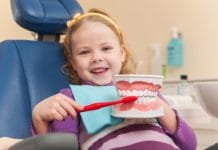Finland takes oral hygiene and the general health of their children very seriously. In 1970, the World Health Organization set the goal of lowering the number of caries in the mouth of Finnish children aged twelve and under. They intended to lower the current DMFT-Index of seven caries to only three per child. Finland’s children had met and surpassed the goal by 1997 with only an average of 1.1 DMFTs per child. Since the initiative began in the 70s, Finland has succeeded in its attempts to educated its children when it comes to dental hygiene but feels that it can do even better.
Since children in the new millennia are becoming more and more dependent on technology, Finland is thinking of using more recent technology to further hygiene education in children and teenagers to lower their DMFT-Index even further. The Effect Of A Brief Computer-Assisted Intervention On Oral Health-Related Behaviours Among Adolescents by A Toratti, M.-L. Laitala, et al., measures the effect a short computer self-assessment and learning tool has on the hygiene practices of children.
The Mission
The researchers’ goal is to discover if the use of technology will be an effective way to reach today’s adolescents and help them form an even more positive dental hygiene routine than they currently had. They believe that if the chosen dental hygiene program related well to today’s children, then the practice can be both a useful and positive step to lowering the already low DMFT-Index. The kids were already receiving information from their parents, dental practitioners, schools, doctors, etc. It was important to add new information with the old to keep the child’s attention.
The Statistics
Almost half of Finland’s children between thirteen and fifteen years old reported brushing less than twice a day, and 70% of them do not eat all of their free and nutritious school lunches. One out of five children eat sweets of some sort during the day at least once a week. This doesn’t jive very well in such an admirably health-conscious country. They fully believe, with good reason, that personal and empowering interventions have positive effects on oral health behaviors.
A computer program made at the University of Oulu that investigates the oral health behaviors of each child while teaching them new information at the same time was given to a group of Finnish high school children who were considered active and healthy in their everyday lives. More than half of the children found the program helpful, easy to understand, and educational. The students also believed that the program was the perfect length at ten to fifteen minutes long.
The Results
Most importantly, the children reported that they were even more aware of how both their diet and predilection towards sugary drinks affect their dental hygiene. The children with the poorest dental health behaviors were tremendously helped with the information and self-analysis that comes with the program. Children began timing their meals appropriately while lowering their use of sugary drinks. They paid more attention to their dental hygiene and have an increased awareness of bacteria, and the havoc it can wreak on oral health.
This study shows that current technology can be used as an effective intervention and education tool to increase the effectiveness of new information for younger teens and pre-teens. It also shows that the practice may be reevaluated as useful for older teens as well as younger ones. Further studies should be done on larger populations for a longer time. The contents of the computer programs should be constantly reevaluated based on a comprehensive education plan that incorporates dental practitioners, parents, schools, and doctors.











